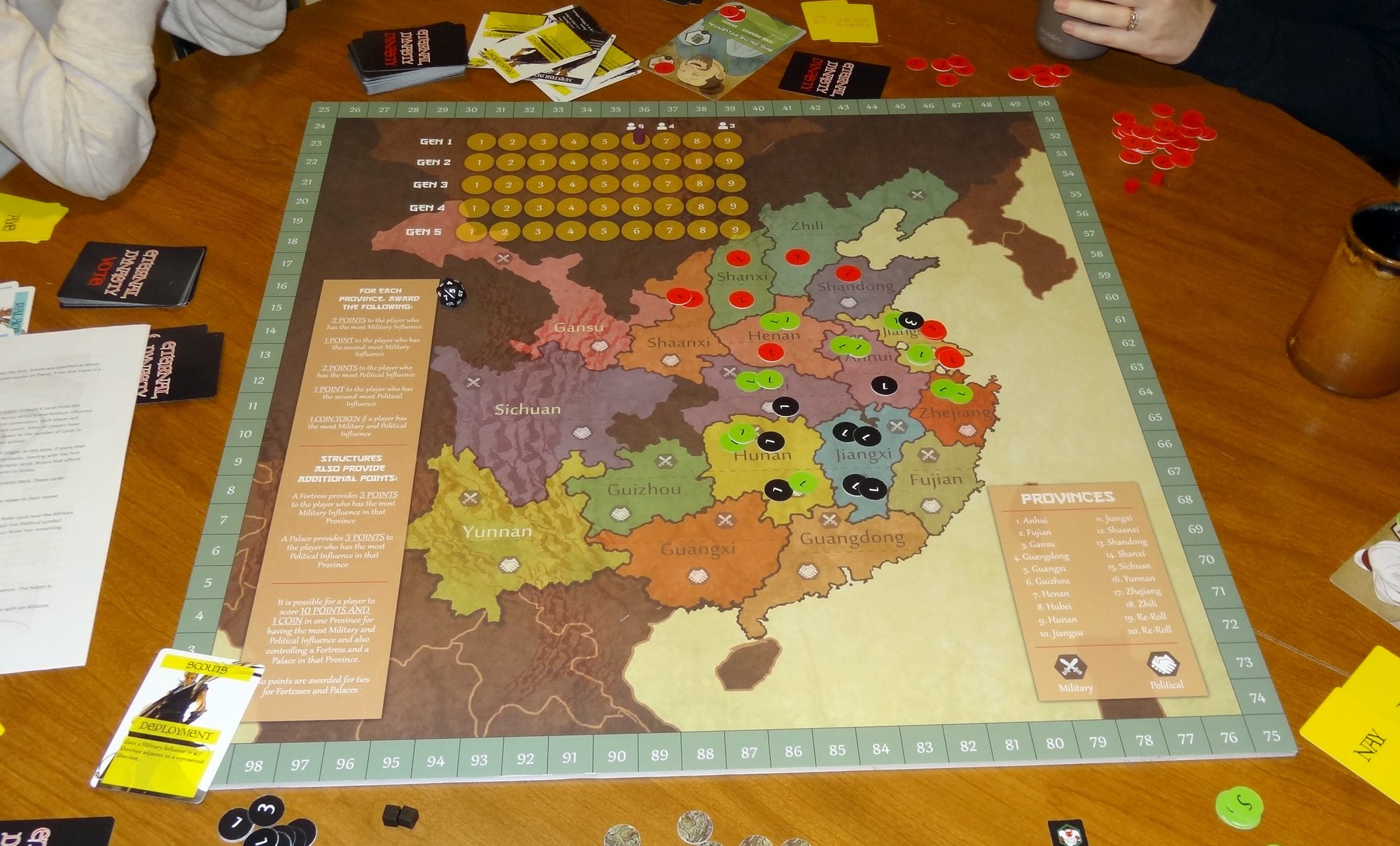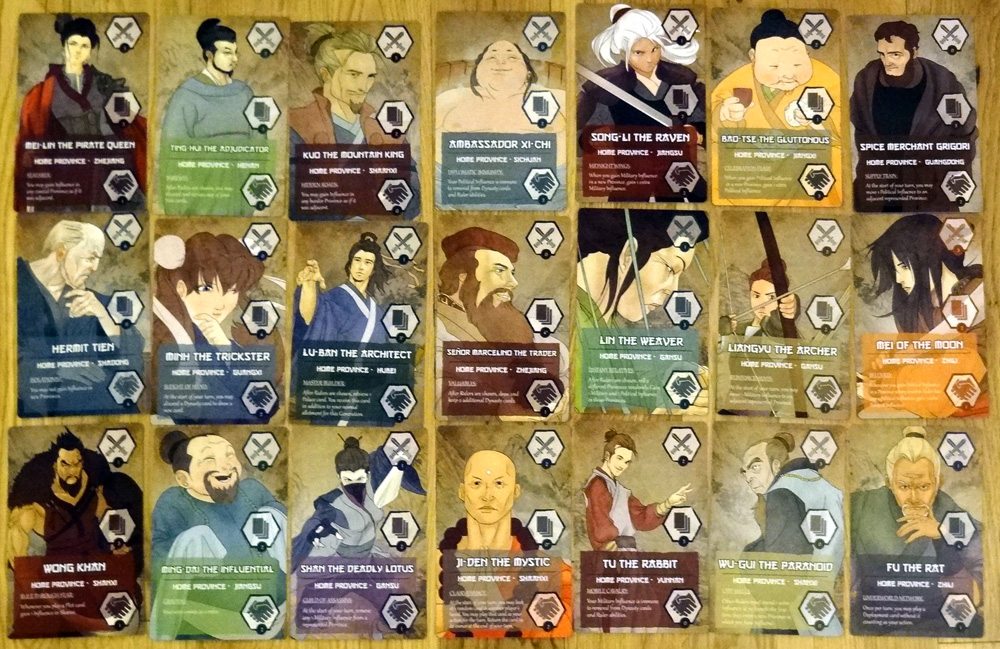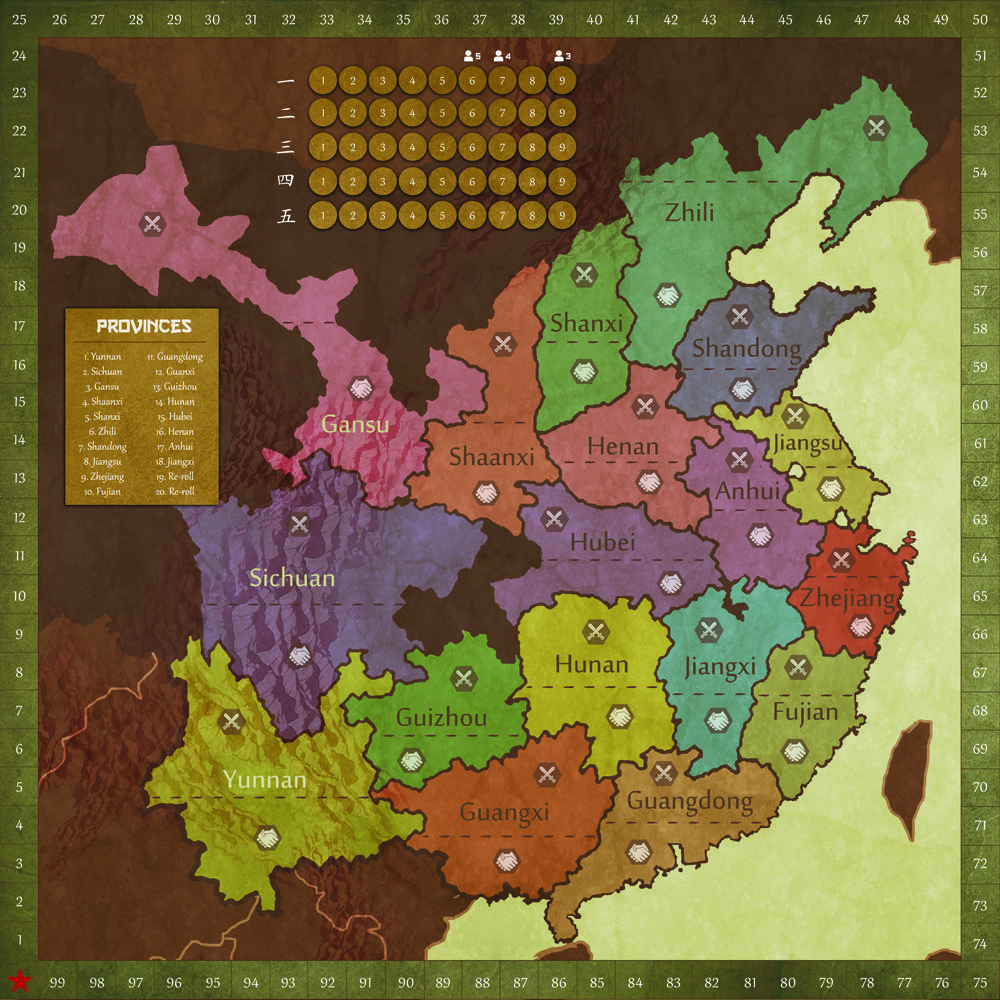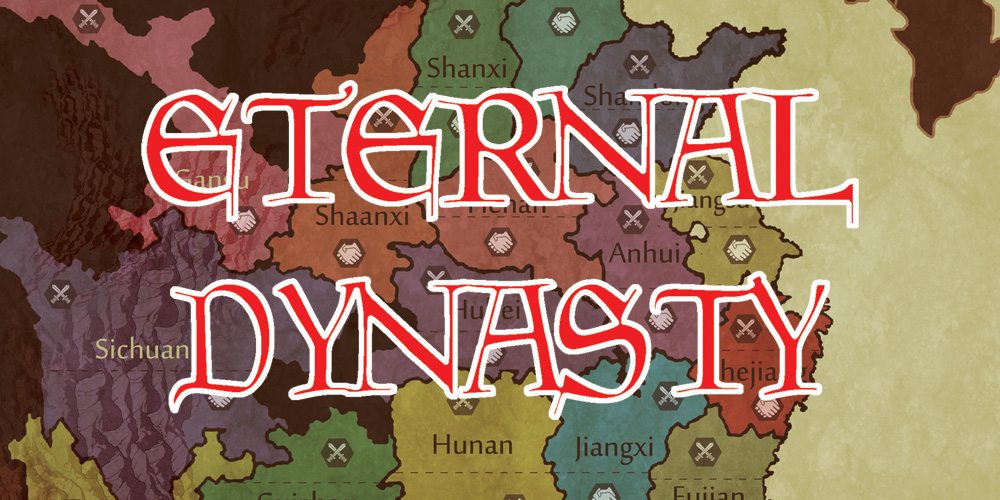
Eternal Dynasty is a board game set in ancient China in which players spread their political and military influence over a series of generations. It just launched on Kickstarter yesterday, and I got a prototype to try out. The gorgeous artwork and simple-to-learn gameplay make for a great combination. If you’re a fan of area-control games and a bit of political maneuvering, it’s worth checking out.
Note: Since my review is based on a prototype, there will be some differences between what is pictured here and the final game, but I will try to indicate those that I know of.
At a glance
Eternal Dynasty is for 3 to 5 players, and takes between an hour and 2.5 hours to play (depending on number of players). The Kickstarter price for the game is $50, with a planned retail price of $60. (There are also higher pledge levels for a deluxe version with a cloth map, or to help design a ruler based on your likeness.) The goal of the game is to score the most points, which is done by controlling provinces by the end of each generation.

Components
The game will come with:
- 1 game board
- 89 Dynasty cards
- 30 Vote cards
- 20 Event cards
- 10 mini Aye/Nay cards
- 36 oversized Ruler cards
- 1 cloth coin bag
- 300 wooden influence tokens
- 5 scoring tokens
- 5 home province tokens
- 10 Leader tokens
- 10 Structure tokens
- 4 Event tokens
- 2 three-player tokens
- 1 1st-player token
- 1 Turn marker
- 1 20-sided die
- 80 coin tokens
As you can see, there’s a good amount of stuff included. The prototype I used had cardstock tokens which can be hard to pick up and move, but the final version will have wooden influence tokens and cardboard tokens, which should be a lot easier to handle. My version also had some finished artwork and some placeholder artwork—what I can say is that the finished artwork is beautiful.

Each of the oversized Ruler cards has unique artwork, and I love the variety of costumes, poses, and composition. It’s not just 36 slightly modified versions of the same basic model. There are men and women, old and young, warriors and diplomats.

The game board, which shows a map of China with various provinces, is also very nicely done, although the odd shapes of some of the provinces can make it difficult for placing a lot of tokens sometimes. The map has been enlarged on the final board, which should help. But it’s attractive enough that I’d consider hanging the prototype board on my wall.

One thing to note about the map is that because the real province names are used, there are some that are very similar, like Shanxi and Shaanxi or Hunan and Henan. It’s unfortunate, but I think I still prefer that to renaming them something imaginary—but you’ll need to watch for those if your gaming group isn’t versed in Chinese geography.

The Dynasty cards, Vote cards, and Event cards didn’t have finished artwork in my prototype, but I’ve seen images of the artwork in progress and it has the same style and quality as the Ruler cards.
How to Play
The full rulebook is available here, so I’ll just hit some of the main ideas.
The game takes place over 3 to 5 generations (based on the number of players), each lasting several rounds. At the end of each generation, you’ll score points based on your influence in each province, and at the end of the game whoever has the most points wins.
At the beginning of each generation, you choose a Ruler, which determines your home province, the number of Dynasty cards you get, the amount of bonus military and political influence you have, and a special ability. Multiple Rulers can hail from the same home province, so you might find yourself in close quarters depending on what the other players choose. Everyone starts with 2 military and 2 political influence in their home province.
Then for each round of the generation, you attempt to spread your influence across the board—you can either gain influence or play a card. Gaining influence is pretty simple: you just add 1 influence (military or political) either in or adjacent to a province where you already have influence. When you do, you can also add any of your bonus influence of the same type. Some Rulers also have special abilities that change the amount of influence you gain, but the basic rule is you just get one.
Cards have more powerful effects—they can let you increase influence, remove your opponents’ influence, or even make alliances that benefit you and another player. Some give you leaders that double your influence in a particular province. Others build structures (fortresses and palaces) which give more points to the winner of that province.

There’s one other factor in the game aside from just jockeying for position: Votes. Each player starts with a number of Vote cards at the beginning of the game, and you can call for a vote before your regular turn once per generation. The votes may allow everyone to build up influence in their home province, or force everyone to reduce military influence, and so on—but you need a majority vote to pass. After some minor discussion (no filibustering!) everyone selects the Aye or Nay card and then reveals it. You can then discard additional Vote cards to add more Aye or Nay votes to the pile—but this means you don’t get to use those to call for votes in future generations. Calling for a vote generates a little bit of influence, but if a measure passes it can cause bigger shifts in the balance of power. As further incentive, players who vote “Aye” usually get an additional perk if the measure passes.
The Rulers have a different mix of abilities, hand size, and bonus influence. For instance, some allow you to add extra influence in new territories, or move influence around at the start of your turn. Others may give you bonuses when you play certain types of Dynasty cards. One of my favorites was the “Sudden But Inevitable Betrayal” power which lets you sacrifice an influence in order to reduce everyone else’s influence in that province.
Once the generation is over, each province is scored separately. For each type of influence, you get 2 points for having the most, 1 point for having second most, and a bonus coin if you have the most of both types. At the beginning of each new generation there’s also an Event card which can affect a province positively or negatively—you might have an earthquake that destroys the structures, or you may find that a particular province is worth extra points (and will thus be hotly contested in the next generation).
After the designated number of generations is over, the game ends. The coins, which are worth between 0 and 2 points, are revealed and added to the scores. The highest score wins.
The Verdict
I haven’t seen too many games set in China, so it was kind of fun to see this art style and theme. The game looked pretty complex when I first opened it up, but it’s actually pretty straightforward—gaining influence is even simpler than in Small World. However, the mix of Rulers, Dynasty Cards, and Votes is where things get really interesting.
My only real concern is the length of the game. The number of generations matches the number of players, with the length of each generation being shorter the more players there are. Each player gets 27 turns in a 3-player game, 28 turns in a 4-player game, and 30 in a 5-player game. That doesn’t sound like a huge difference, but you’re going from 81 total turns to 112 turns to 150 turns, which is a lot longer.
The 3- and 4-player games are pretty manageable, but 5 generations just seems really long for the type of game this is. The idea is that every player gets to be starting player for a generation, but I think it gets to be a little much, but shortening the generations even more might not allow for enough strategic planning. Our solution was just to play fewer generations, which may not be perfectly balanced but I think comes close enough.
Other than the game length in a 5-player game, though, I really liked it. Most turns (unless there’s a Vote) go fairly quickly and I enjoyed planning how to use my cards and special ability to take over key provinces. We did notice that it’s possible to get an early lead, but there’s a natural balancing factor in this sort of game because everyone piles on the leader. However, since the game ends after a set number of rounds rather than number of points, beating up the leader doesn’t make the game drag on forever, it just reduces the point spread.
It’s hard to say how evenly balanced the various Rulers are, since there are so many of them. But since you get dealt 3 each generation and get to choose one, you can try to find one that will build on your current position and the cards you have. Also, since you always get some starting influence in your home province at the beginning of each generation, you can select a Ruler with an advantageous position on the board even if the ability isn’t your favorite.
It is an area-control game, so if you enjoy that type of game it’s worth taking a closer look at Eternal Dynasty. With the simple influence mechanic and political vote-calling, it has some enjoyable differences from games like Risk and Small World. If you don’t like area control games, I’m not sure that the differences will be enough to change your mind, unless you particularly like the ancient China theme.
For more info and to back the project, visit the Eternal Dynasty Kickstarter page.
Thanks to Nicholas Yu of Zucchini People Games for providing a prototype copy!




Extremely biased here, but thanks for the excellent article!
It was an enjoyable game – with game length for 5-player games and the difficulty of seeing at a glance who was ahead in each province being my major concerns. Hopefully, 4 players is the sweet spot, and the wooden tokens vs the card ones make seeing easier (though if it was earlier in development, I think stackable tokens would make seeing who has the most influence at a glance a snap).
I want to play it again!
Thanks for the feedback. I have included a shorter 5-player game variant which addresses the length of the game concerns that runs for only 4 Generations instead of 5. It does mean the rotations for first and last players aren’t totally even, but I think it’s a good compromise if you want a shorter game.
We’ve been playing with beads and cubes and it’s been easy to see Influence at a glance. Also, I totally wish I had thought of stackable tokens earlier on!
The larger final map than the playtest one probably helps too. As for stackable tokens – stretch goal! 🙂
Indeed. After rearranging the rest of the design elements, we were able to blow up the province size by about 20%.
Definitely a great idea for a Stretch Goal, but I’d just be thrilled with funding first!